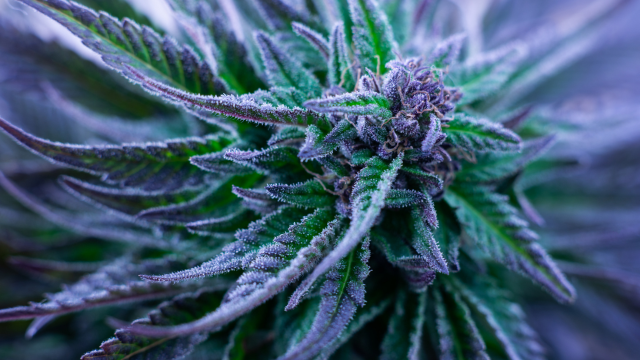TL;DR Quick Hit: The Real Deal on Cannabis Colors
Here’s the short and sticky: purple weed isn’t magically more potent than green weed, and that deep violet hue doesn’t mean you’re in for a stronger high. It’s all about plant genetics, pigments like anthocyanins, and a little environmental flair (hello, cool nights). When it comes to choosing your bud, the cannabinoid and terpene profile matter way more than what color your nug is flexin’.
Why Is Weed Green (Most of the Time)?
Let’s start with the classic. That lush, leafy green weed we all know and love owes its color to chlorophyll, the same green pigment that makes spinach, kale, and your houseplants photosynthesize like pros. Chlorophyll helps the plant turn sunlight into energy, and in most cannabis strains, it’s the dominant pigment by a mile.
But not all green weed looks the same. Some strains pop off with bright lime tones, while others lean toward deep forest green vibes. That variation? It comes down to a strain’s genetic makeup, growing conditions, and how much TLC it got along the way. You’ll often see greener hues in strains grown under strong lights with steady temps and nutrient-rich soil.
So… What Makes Weed Purple?
Now let’s talk about the real head-turner: purple weed. No, it’s not dyed. No, it’s not laced or sprayed. And no, it’s not grown by unicorns under moonlight…although that would be cool.
Purple weed gets its signature color from anthocyanins, which are flavonoids found in lots of plants, like blueberries and blackberries. These pigments can show up red, blue, or purple, depending on the plant’s pH and environment. In cannabis, anthocyanins shine through when certain conditions are just right, mainly cooler nighttime temperatures during the late flowering stage.
Not every plant can pull this off. You need strains with the right purple genetics, which is why so many of them include “Purple” in the name. (Yes, it’s a little on-the-nose, but we love that for them.)
Green and Purple Weed: What’s the Difference, Really?
Here’s the tea: green and purple weed look different, but that’s about where the differences end. When it comes to how a strain hits, it’s not about color; it’s about terpenes and cannabinoids.
You might hear folks say purple strains are more relaxing or that green ones are stronger. That’s anecdotal, not scientific. Is purple weed stronger than green? Nope. Color doesn’t control potency; THC and other cannabinoids do. If you really want to know what you’re getting into, check the lab results or ask your friendly neighborhood budtender.
Want to Grow Purple Weed? Here’s How
Growing purple weed is part science, part art, and a whole lotta patience. If you’re hoping to harvest some Technicolor flower at home, start with strains that are genetically wired for purple. That’s non-negotiable. No amount of temp tweaking will turn Green Crack into Purple Urkle.
Once you’ve got the right seeds, here’s what to focus on:
- Pick a purple-friendly strain. Look for names like Purple Haze, Purple Punch, or Granddaddy Purple. The classics know what’s up.
- Cool things down (just a bit). Drop your nighttime temps in late flower by 10–15°F to let those anthocyanins strut their stuff.
- Balance your pH. Slightly more acidic soil can encourage purpling, but don’t go full mad scientist.
- Keep your plants happy. Stressing them out too much with cold can backfire. A shivering plant is not a thriving plant.
- Watch for the fade. Purpling usually kicks in close to harvest. Don’t rush it.
Pro Tip: Just remember, color is cool, but healthy, frosty buds with good cannabinoid content should still be your #1 goal.
Looks Good, Feels Better
At the end of the day, green vs purple is more of a visual vibe check than a performance showdown. Whether you like your bud to look like a pine tree or a grape popsicle, the real magic is in how it makes you feel.
Always look at the lab-tested THC levels, CBD content, and those juicy terpene profiles to decide what suits your vibe, not just the shade of the flower. Because when it comes to getting lifted, color doesn’t equal quality. It just makes your stash jar look extra photogenic.
Frequently Asked Questions About Purple Weed
What makes weed purple?
Purple weed gets its color from anthocyanins, pigments that show up when the right genetics meet cool nighttime temps.
Is purple weed stronger than green?
Nope. Potency is based on cannabinoids and terpenes, not the color of the buds.
Can I grow purple weed at home?
Yes! Just pick a strain with purple genetics and lower the temps during late flowering — gently though, don’t frost your plants out.
Why is green weed more common?
Most cannabis strains are packed with chlorophyll, which naturally gives them a green color. Purple requires special genetics and a cooler grow environment.
Final Thoughts: Don’t Judge a Bud by Its Color
The cannabis rainbow is a beautiful thing: from bright green to deep purple and everything in between. But don’t let looks cloud your judgment. Whether it’s green weed, purple weed, or some wild hybrid of the two, the most important factor is always how it affects you. So smoke smart, stay curious, and maybe show off your purple nug on Insta…just don’t expect it to hit harder based on looks alone.
Do you prefer green or purple weed? Hit me up on social media, and let’s spark up a conversation about it!
